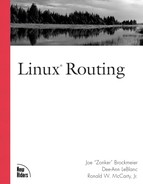Summary
The unicast routing protocols you’re most likely to use in large, subnetted or multi- net-work networks in Linux are RIP-1, RIP-2, and OSPF. RIP-1 is the oldest of TCP/IP routing protocols still used on the Internet.As such, it is also the least flexible and only really good for small networks. RIP-2 is a bit newer and more secure, and while it is really not any better for larger networks, is a wiser choice than RIP-1 in many situations. Finally there is OSPF, which is more robust. If your network tends to change or you have problems with machines going down, you’re better off to choose this option.
Don’t forget static routing either! For really small LANs (10 machines or so) or subnets, this might be sufficient. Table 1.6 lists pertinent data for each of the protocols that might be of interest to you.
| Protocol | Program | RFC |
|---|---|---|
| RIP-1 | routed, gated, or zebra | 1058 |
| RIP-2 | gated or zebra | 1721 |
| OSPF | gated or zebra | 2328 |
One excellent place to read Request for Comments (RFCs) is http://www.faqs.org/. If you are a programmer and find that you have a hard time understanding how some things work until you can pour over some code, then go to http://www.packetfactory.net/ and examine their libnet project’s code. There are features in there for handling RIP-1 and OSPF.
